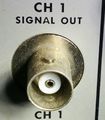BNC connector: Difference between revisions
Jump to navigation
Jump to search
(Redirected page to Connectors#BNC) |
No edit summary |
||
| Line 1: | Line 1: | ||
[[File:Bnc female.jpg|250px|thumb|right|"Female" BNC connector]] | |||
'''BNC''' (from ''Bayonet Neill–Concelman'', sometimes erroneously named ''Bayonet Naval Connector'') is the most common coaxial connector standard for measurement equipment up to 1 GHz. | |||
It was patented in 1951 by Hazeltine Research, Inc. | |||
It is available in different impedances. 50 Ω is the most common. | |||
Tektronix gear transitioned from [[Connectors#UHF|UHF connectors]] to BNC connectors in | |||
the early to mid-1960's. For some pieces of equipment, a conversion kit was | |||
available. | |||
==Links== | |||
* [http://en.wikipedia.org/wiki/BNC_connector Wikipedia: BNC connector] | |||
* [http://w140.com/us_patent_2540012_bnc_connector.pdf BNC Connector Patent (PDF)] | |||
==Pictures== | |||
<gallery> | |||
File:Bnc female.jpg|BNC Female | |||
File:Bnc male.jpg|BNC Male | |||
</gallery> | |||
[[Category:Connectors]] | |||
Revision as of 08:02, 7 July 2015

BNC (from Bayonet Neill–Concelman, sometimes erroneously named Bayonet Naval Connector) is the most common coaxial connector standard for measurement equipment up to 1 GHz.
It was patented in 1951 by Hazeltine Research, Inc. It is available in different impedances. 50 Ω is the most common.
Tektronix gear transitioned from UHF connectors to BNC connectors in the early to mid-1960's. For some pieces of equipment, a conversion kit was available.
Links
Pictures
-
BNC Female
-
BNC Male

